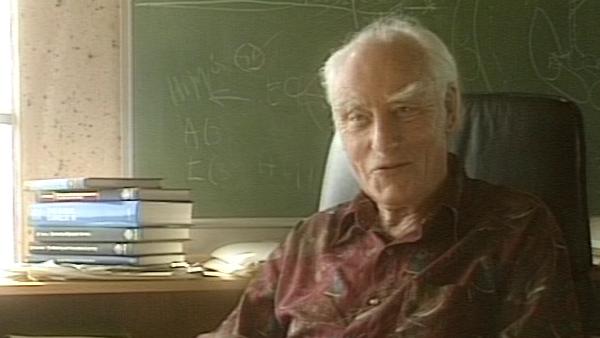NEXT STORY

Speed in scientific research is a relative thing
RELATED STORIES

NEXT STORY

Speed in scientific research is a relative thing
RELATED STORIES


|
Views | Duration | |
|---|---|---|---|
| 61. Chefs against DNA! | 504 | 00:46 | |
| 62. Scientific advances as a result of the discovery of DNA | 1 | 435 | 01:56 |
| 63. Speed in scientific research is a relative thing | 398 | 00:43 | |
| 64. Would Darwin understand DNA? | 1 | 933 | 01:22 |
| 65. The idea of natural selection is formed | 477 | 01:09 | |
| 66. Natural selection: the essence of the idea | 490 | 01:42 | |
| 67. Explanation of species change before natural selection | 394 | 00:49 | |
| 68. Charles Darwin's career path | 559 | 01:25 | |
| 69. Adam and Eve: myth-busting | 580 | 00:39 | |
| 70. Thoughts on religion | 2 | 1149 | 02:07 |


We saw, essentially, all the developments up to about the middle '60s. We saw the idea of replication, we saw the idea that would be an RNA messenger which you… you make a working copy of the gene and send it off to the machinery which does the protein synthesis and so on. We had the idea of mRNA although we made a mistake about that in detail and we had the right ideas about protein synthesis. What we didn’t see was two things: how easy it would be to sequence DNA, which was done independently by two groups, one in America and one in… in Cambridge, England… one in Cambridge, Massachusetts and one in Cambridge, England.
[Q] The sequence?
Yes, actually work out the actual sequence of the four letters which make up the… the message and that can be done now and, of course, is being done at enormous rates nowadays because the methods get better and better. But that was one of the big breakthroughs and the other breakthrough was the business of being able to… by using enzymes, by using natural molecules which perform certain reactions, to be able to cut DNA, join DNA, match up DNA and manipulate it and put it from one place into another and join it up and essentially be able to handle it, you might say, using often single copies which then by biological magnification you could just make as many copies as you want by putting it into a bacterium or whatever it is and letting the bacterium grow till you got as many copies as you want. So, by using all these tricks which are based on making, as it were, nature do the work and using the base pairing of the DNA to help you do the manipulation, you can do many things and none of that we foresaw because it was… again, it was too far ahead. In terms of time it was between 20 and 25 years ahead and that’s a difficult time to… that’s where, generally speaking, it’s difficult to see what’s going to happen.
The late Francis Crick, one of Britain's most famous scientists, won the Nobel Prize in Physiology or Medicine in 1962. He is best known for his discovery, jointly with James Watson and Maurice Wilkins, of the double helix structure of DNA, though he also made important contributions in understanding the genetic code and was exploring the basis of consciousness in the years leading up to his death in 2004.
Title: Scientific advances as a result of the discovery of DNA
Listeners: Christopher Sykes
Christopher Sykes is an independent documentary producer who has made a number of films about science and scientists for BBC TV, Channel Four, and PBS.
Tags: United States of America, Cambridge, England, Massachusetts
Duration: 1 minute, 56 seconds
Date story recorded: 1993
Date story went live: 08 January 2010